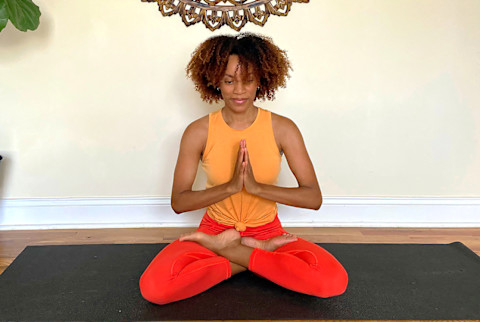How To Do Lotus Pose (Padmasana) In Yoga, Plus Benefits & Modifications

Lotus pose, or padmasana, is an excellent stretch for releasing the hips—which are a problem point for a lot of people. Over time, the effects of frequent sitting and poor posture can result in closed and stiff hips. Not to mention, hips can hold a lot of the trauma that's stored in our body.
If any of that sounds familiar, you might want to consider adding some lotus (and even half lotus pose, if the full extension isn't available to you) into your yoga rotation. Here's how to get into it, as demonstrated by certified yoga and meditation instructor Pilin Anice.
How to do lotus pose (padmasana):
- Sit down on your mat with legs out in front of you. Bringing the right leg toward you, position the knee in your right elbow and the ankle in your left elbow.
- Try to grab opposite hands around your shin, and gently rock around here, loosening up the hip.
- With the right leg still in your arms, bend your left foot in toward you with the knee dropping toward the ground (like half of a cross-legged seat).
- Flexing your right foot, bring it over your left leg to your left hip, and press down into your groin. Hold for a moment.
- Lean forward and reach for your left shin, sliding your flexed left foot up and over to your right knee to your right hip. Keep both feet flexed and active, and imagine your hips are rotating out, bringing the outside of your thighs closer to the ground.
- Hold for a few breaths—know this is not a pose you need to hold long, especially if you're just starting to practice it. Exit by taking your legs in your hands and bringing them back to your original seat.
- Always practice crossing both legs each time (once with the right leg on top, once with the left).
Tips and modifications
- If the full extension isn't in reach for you right now, half lotus, or ardha padmasana, will help you get there. Once the first leg is tucked into the opposite hip, bring the other leg underneath it. Switch and repeat on the other side.
- Pigeon, lizard, and butterfly poses will help you develop the external rotation in the hips necessary for full lotus.
Benefits of lotus
Lotus is a challenging hip opener with lots of benefits. In addition to releasing tight hips, it also encourages a straight and strong spine, which can help improve your posture. In addition to that, it stretches the ankles and knees, loosening up all those joints in the low body.
On top of the physical benefits, lotus is a great pose for working with the root chakra. This chakra is all about stability but can be blocked by fear. When we sit in lotus, the base of the spine is rooted into the earth, lending a sense of calm connection and grounding to the present moment. There's a reason this pose is a popular way to sit for meditation.
So, whether you want to release those hips or get yourself grounded, lotus can lend a hand. Try repeating a mantra or quick meditation while sitting, or incorporating it into your next yoga sesh. However you choose to practice it, your hips will definitely thank you.
